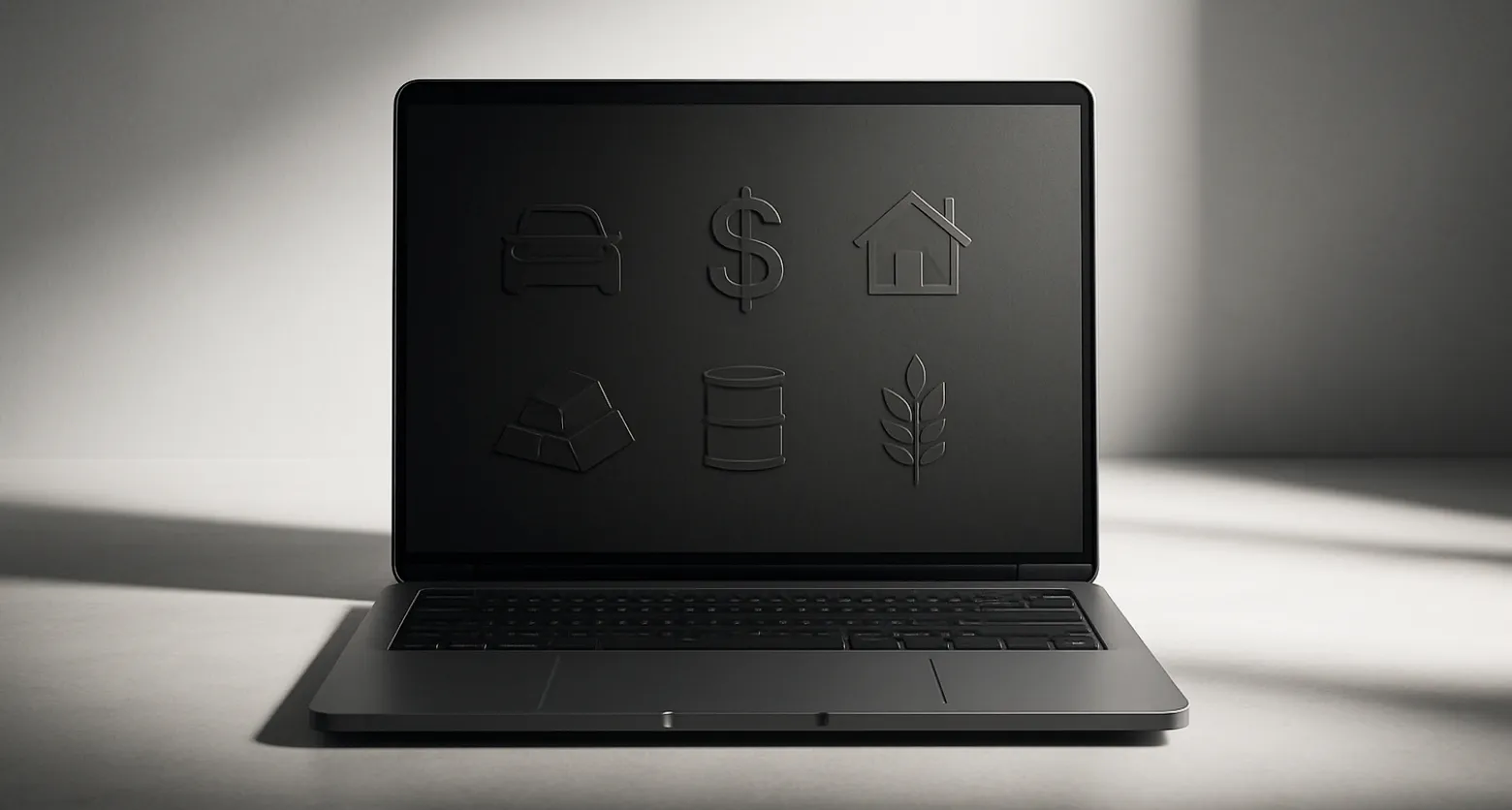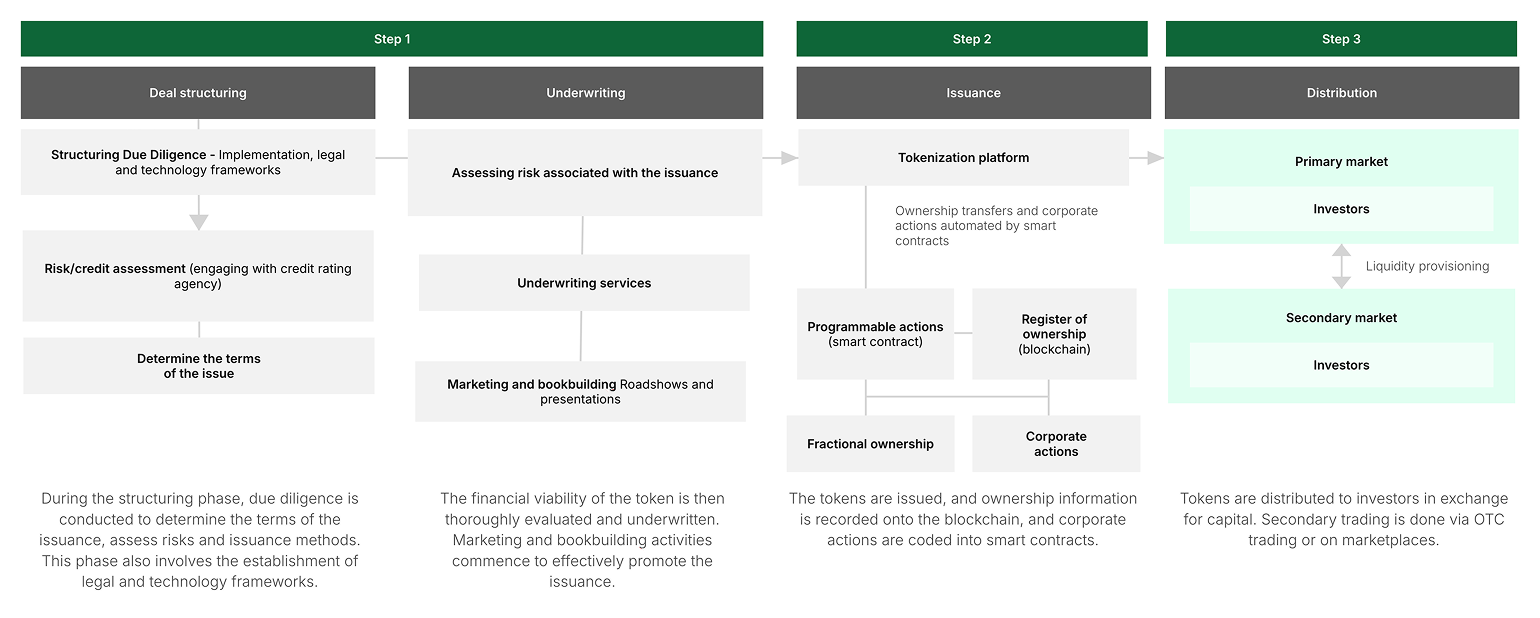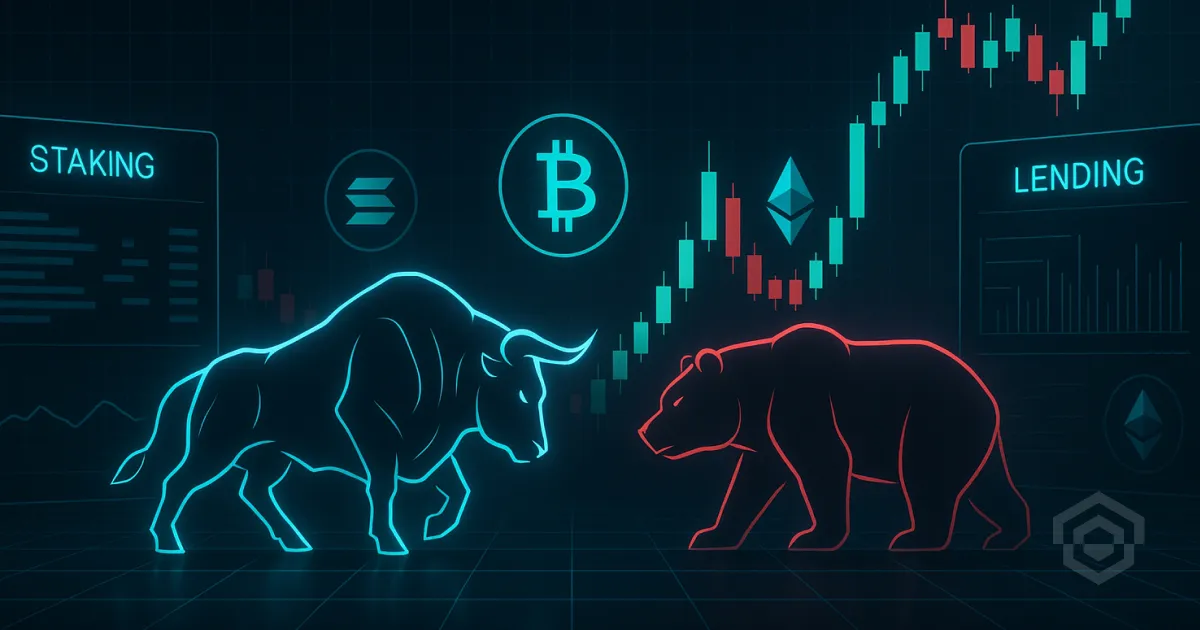

Tokenization platforms explained – Technology, custody & compliance. | AI generated image by XBTO
In 2025, over $30 billion in tokenized assets are live on-chain, spanning tokenized treasuries, hedge funds, and private credit instruments. This rapid growth is being driven by institutional-grade platforms like Securitize, Tokeny, and Fireblocks, which combine blockchain technology with custody and compliance layers designed for regulated investors.
In this article, we’ll explain how tokenization platforms work, the technology behind them, how they integrate custody and compliance, and what institutions should evaluate before adopting them.
What are tokenization platforms?
Tokenization platforms are essentially specialized RWA tokenization software suites that streamline the complex legal and technological procedures required to transfer traditional assets onto distributed ledger technology (DLT). These systems enable issuers to manage the asset, its investors, and all ongoing corporate actions programmatically.
Tokenization offers powerful features to solve long-standing problems in traditional finance:
- Programmability: Tokens are smart assets, allowing automated enforcement of complex rules like dividend payments, interest disbursements, and compliance checks. This automation reduces manual intervention, administrative costs, and reliance on intermediaries.
- Fractionalization: High-value, illiquid assets like real estate, fine art, or private equity can be divided into smaller, tradeable units. This democratizes access and significantly unlocks value previously trapped in assets.
- Global reach and efficiency: Tokens operate on borderless blockchain networks, dramatically reducing transaction costs and friction associated with cross-border payments and transfers. Settlement times can be reduced from days to near-instantaneous real-time finality.
Every robust token issuance platform is built on three interconnected layers that together create a secure and efficient digital ecosystem:
- The technology layer: This involves the Distributed Ledger Technology (DLT) itself (e.g., Ethereum, Avalanche, Polygon), which serves as the decentralized, tamper-proof record of ownership. Modern platforms are highly adaptable and often multi-chain, resolving the early issues of scalability and high transaction costs.
- The custody layer (Institutional custody): Custody systems interact with the digital tokens, providing the secure storage and management of the cryptographic keys that prove ownership of the asset. Providers must offer enterprise-grade security, often utilizing advanced methods like MPC.
- The compliance layer (Smart contracts & policy): This is where regulatory requirements (KYC/AML, investor accreditation, geographic restrictions) are hardcoded into the token itself using standards like ERC-3643 or ERC-1400. The platform ensures only verified parties can interact with the token throughout its lifecycle.
How tokenization platforms work: The asset lifecycle
RWA tokenization software handles the multi-stage process of converting an asset into a token. This ensures transparency, compliance, and operational efficiency.
The initial stage involves defining the asset’s legal and technical structure. Due diligence is performed, and the platform determines the type of tokens to be created (e.g., equity, debt, utility).
- Due diligence and risk assessment: Platforms conduct legal, financial, and technological assessments. For instance, if credit risk is involved, they collaborate with credit rating agencies or financial institutions.
- Underwriting Support: Tokenization platforms explained often offer underwriting services, guaranteeing the sale of a certain number of tokens to ensure the issuer meets their funding goals.
This step represents the technological heart of tokenization.
Token creation: Digital tokens are minted, representing fractional ownership or other rights tied to the asset. These tokens are governed by programmable smart contracts that automate corporate actions such as dividend payments and ownership transfers.
Platform examples:
- Securitize provides a platform for issuing tokenized funds and securities, acting as a regulated transfer agent and FINRA-registered ATS (Alternative Trading System) in the U.S.. It utilizes smart contracts for security tokens and supports tokens gated by identity/KYC requirements.
- Tokeny focuses on the European market (Luxembourg-based), using the open-source ERC-3643 standard on EVM-based chains like Avalanche for high-speed institutional tokenization
Once tokens are issued, they are distributed to investors through primary markets and can subsequently be traded. The presence of secondary markets is crucial for enabling token holders to unlock liquidity as needed.
Platforms are working hard to enhance liquidity through technological integration:
- Stablecoin integration: Securitize recently introduced real-time liquidity for its tokenized funds by integrating Ripple’s RLUSD dollar stablecoin. This allows investors to instantly swap tokenized fund shares for cash stablecoins while maintaining exposure to the underlying yield.
- Regulated venues: In the U.S., platforms like tZERO operate as a FINRA-regulated ATS and broker-dealer, facilitating the secondary trading of digital securities among accredited investors.
- Interoperability: Platforms are leveraging specialized networks, such as Ownera's FinP2P, which acts as a routing protocol to connect multiple blockchains (Corda, Canton, Ethereum) to enable cross-platform liquidity. This enables assets tokenized on one network to be distributed globally through a unified interface.
Institutional adoption hinges on robust custody, the ability to hold tokenized assets with the same assurance as traditional securities.
Multi-party computation (MPC) custody
Fireblocks’ MPC technology eliminates single points of failure by splitting cryptographic keys across secure nodes. Keys never exist in one place, mitigating insider or hacker risk.
Fireblocks’ multi-layer architecture includes:
- Layer 1: MPC cryptographic key protection.
- Layer 2: SGX enclaves to isolate sensitive data.
- Layer 3: Policy engine enforcing transaction approval workflows.
XBTO’s custody solutions also leverage Fireblocks’ MPC infrastructure and bankruptcy-remote wallets regulated under BMA and ADGM licenses.
Insurance & risk controls
Institutions often require crime insurance coverage (e.g., via RELM or Munich Re) for digital asset custody. Policies can cover theft, insider fraud, or key compromise.
Segregation & transparency
Custody accounts are fully segregated and verifiable on-chain, giving investors auditable proof of ownership, a key institutional trust element.
Compliance and regulatory frameworks
Institutional tokenization thrives under clear and converging regulation.
Platforms like Securitize operate under SEC and FINRA supervision as a registered transfer agent and broker-dealer, allowing compliant trading of tokenized funds. The recent GENUS Stablecoin Act (2025) provides clarity for tokenized payment instruments and stablecoin-backed RWAs.
The MiCA framework and DLT Pilot Regime enable cross-border issuance and trading of digital securities under existing securities laws. Tokeny, operating from Luxembourg, structures ERC-3643 tokens for regulated issuers under EU law.
The ADGM and SCA’s 2025 tokenization framework formally recognize security and commodity tokens as legal assets, providing licensing clarity and streamlined approval for issuers.
Built-In compliance tools
Modern tokenization platforms embed regulatory safeguards directly into their architecture:
- On-chain KYC/AML verification.
- FATF Travel Rule integration (Fireblocks’ Payments Network, Notabene).
- Blacklist/whitelist controls to restrict transfers to approved wallets.
- Automated reporting & audit APIs for regulators and fund administrators.
This “compliance-by-design” model drastically reduces manual oversight and regulatory risk while improving transparency.
Evaluating tokenization platforms (for institutions)
When assessing tokenization infrastructure, institutions should consider security, interoperability, and regulatory assurance.
Key trends shaping tokenization platforms
The tokenization infrastructure landscape is rapidly evolving, driven by the convergence of technology and regulatory demands. Recent market developments underscore a strong institutional focus, with the on-chain real-world asset (RWA) market surpassing $30 billion in value.
The rise of on-chain treasuries and regulated stablecoin liquidity
Tokenized treasury bill funds and money market funds have become a massive growth category. BlackRock’s BUIDL fund is a notable example, approaching $2.8 billion in assets across seven blockchains.
- These funds, structured typically as tokenized shares, offer crypto market participants access to yield on short-term government debt.
- Critically, these tokenized treasuries are now serving as reserve assets for regulated stablecoins. Anchorage’s USDtb, the first OCC-regulated stablecoin, is largely collateralized by tokens like BlackRock’s BUIDL. This integration creates a high-confidence, intertwined on-chain money market ecosystem.
- Furthermore, payment networks like the one launched by Fireblocks connect institutions across 100+ countries using unified APIs for stablecoin settlement, ensuring compliant cross-border cash movement.
Interoperability and the ERC-3643 standard
Technological silos remain a challenge, as tokenized assets reside on diverse ledgers. Interoperability is the solution to achieving truly global liquidity.
- The widespread adoption of ERC-3643 by key industry participants, including DTCC, Deloitte, and ABN AMRO, signifies its role as the compliance standard for regulated tokens. This adoption ensures that the compliance rules travel with the asset, regardless of the trading platform.
- Protocols and alliances are emerging to bridge networks. The Global RWA Alliance is dedicated to establishing frameworks that allow an asset on one network (e.g., a tokenized bond) to be seamlessly used as collateral on another. Ownera’s FinP2P network is already routing tokenized assets across multiple institutional blockchains.
Modular and white-label RWA tokenization software
Instead of building proprietary solutions from the ground up, many RWA issuers are opting for modular, white-label services.
- Fireblocks, for instance, offers a tokenization engine that allows institutions to mint tokens and manage cap tables securely.
- Platforms like Tokeny integrate with MPC custody modules (such as Hex Trust) so that clients receive a seamless, one-stop solution for both issuance and secure storage. This trend professionalizes the custody of tokenized assets, ensuring the same rigor as traditional custody.
Tokenizing new asset classes
Tokenization is expanding beyond traditional debt and equity. The ecosystem is now seeing:
- Tokenized reinsurance products and structured products.
- Experiments with tokenized infrastructure assets and cash flows derived from AI compute.
- Development of ISO-standard reference data for on-chain assets, aiming to bring CUSIP/ISIN equivalents onto the ledger.
These advancements signal that tokenized finance is moving from isolated projects to becoming an embedded layer within the core systems of capital markets.
The backbone of digital finance
Tokenization platforms form the operational and technological core of institutional digital asset markets. They blend blockchain innovation with the rigorous custody and compliance controls required by global regulators.
As adoption accelerates, institutions choosing the right platform should focus on regulated licensing, custody integration, and compliance automation — the pillars of trust in digital finance.
The next phase of institutional adoption will hinge on interoperability, allowing tokenized assets to flow seamlessly across markets and jurisdictions.
The full breakdown
In our first article, "Navigating Crypto Volatility: The Advantages of Active Management," we explored how the high volatility and low correlation of digital assets with traditional asset classes create unique opportunities for active managers. We discussed how these characteristics enable active managers to execute tactical trading strategies, capitalizing on short-term price movements and market inefficiencies. Building on that foundation, we now turn our attention to the unique market microstructure of digital assets.
Conducive market microstructure of digital assets
The market microstructure of digital assets - a framework that defines how crypto trades are conducted, including order execution, price formation, and market interactions - sets the stage for active management to thrive. This unique ecosystem, characterized by its continuous trading hours, diverse trading venues, and substantial market liquidity, offers several advantages for active management, providing a fertile ground for sophisticated investment strategies.
24/7/365 market access
One of the defining characteristics of digital asset markets is their continuous, round-the-clock operation.
Unlike traditional financial markets that operate within specific hours, cryptocurrency markets are open 24 hours a day, seven days a week, all year round. This continuous trading capability is particularly advantageous for active managers for several reasons:
- Immediate response to market events: Unlike traditional markets that close after regular trading hours, digital asset markets allow managers to react immediately to breaking news or events that could impact asset prices. For instance, if a significant economic policy change occurs over the weekend, managers can adjust their positions in real-time without waiting for markets to open.
- Managing volatility: Continuous trading provides more opportunities to capitalize on price movements and volatility. Active managers can take advantage of this by implementing strategies such as short-term trading or hedging to mitigate risks and lock in gains whenever market conditions change. For instance, if there’s a sudden drop in the price of Bitcoin, managers can quickly sell their holdings to minimize losses or buy in to capitalize on the lower prices.
Variety of trading venues
The proliferation and variety of trading venues is another crucial element of the digital asset market structure. The extensive landscape of over 200 centralized exchanges (CEX) and more than 500 decentralized exchanges (DEX) offers a wide array of platforms for cryptocurrency trading. This diversity is beneficial for active managers in several ways:
- Risk management and diversification: By spreading trades across various exchanges, active managers can mitigate counterparty risk associated with any single platform. Additionally, the ability to trade on both CEX and DEX platforms allows managers to diversify their strategies, incorporating different levels of decentralization, regulatory environments, and security features.
- Arbitrage opportunities: Different venues often exhibit price discrepancies, presenting arbitrage opportunities. For example, managers can buy an asset on one exchange at a lower price and sell it on another where the price is higher, thus generating risk-free profits.
- Access to diverse liquidity pools: Multiple trading venues provide access to diverse liquidity pools, ensuring that managers can execute large trades without significantly impacting the market price.
Spot and derivatives markets (Variety of instruments)
The seamless integration of spot and derivatives markets within the digital asset space presents a considerable advantage for active managers. With substantial liquidity in both markets, they can implement sophisticated trading strategies and manage risk more effectively.
For instance, as of August 8 2024, Bitcoin (BTC) boasts a daily spot trading volume of $40.44 billion and an open interest in futures of $27.75 billion. Additionally, derivatives such as futures, options, and perpetual contracts enable managers to hedge positions, leverage trades, and employ complex strategies that can amplify returns.

Overall, the benefits for active managers include:
- Hedging and risk management: Derivatives offer a powerful tool for hedging against unfavorable price movements, enabling more efficient risk management. For instance, a manager holding a substantial amount of Bitcoin in the spot market can use Bitcoin futures contracts to safeguard against potential price drops, thereby enhancing risk control.
- Access to leverage: Managers can use derivatives to leverage their positions, amplifying potential returns while maintaining control over risk exposure. For instance, by employing options, a manager can gain exposure to an underlying asset with only a fraction of the capital needed for a direct spot purchase, thereby enabling more capital-efficient investment strategies.
- Strategic flexibility: By integrating spot and derivatives markets, managers can implement sophisticated strategies designed to capitalize on diverse market conditions. For instance, they may engage in volatility selling, where options are sold to generate income from market volatility, regardless of price direction. Additionally, managers can leverage favorable funding rates in perpetual futures markets to enhance yield generation. Basis trading, another strategy, involves taking offsetting positions in spot and futures markets to profit from price differentials, enabling returns that are independent of market movements.
Exploiting market inefficiencies
Digital asset markets, being relatively nascent, are less efficient compared to traditional financial markets. These inefficiencies arise from various factors, including regulatory differences, market segmentation, and varying levels of market maturity. For example:
- Pricing anomalies: Phenomena like the "Kimchi premium," where cryptocurrency prices in South Korea trade at a premium compared to other markets, create arbitrage opportunities. Managers can exploit these by buying assets in one market and selling them in another at a higher price.
- Exploiting mispricings: Active managers can identify and capitalize on mispricings caused by market inefficiencies, using strategies such as statistical arbitrage and mean reversion.
The unique aspects of the digital asset market structure create an exceptionally conducive environment for active management. Continuous trading hours and diverse venues provide the flexibility to react quickly to market changes, ensuring timely execution of trades. The availability of both spot and derivatives markets supports a wide range of sophisticated trading strategies, from hedging to leveraging positions. Market inefficiencies and pricing anomalies offer numerous opportunities for generating alpha, making active management particularly effective in the digital asset space. Furthermore, the ability to hedge and manage risk through derivatives, along with exploiting uncorrelated performance, enhances portfolio resilience and stability.
In our next article, we'll delve into the various techniques active managers employ in the digital asset markets, showcasing real-world use cases.
Read full disclaimer













